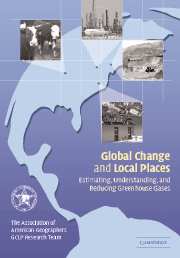Book contents
- Frontmatter
- Contents
- List of contributors
- Foreword
- Preface
- Acknowledgments
- Part One Global change and local places
- Part Two Learning from localities
- Part Three Beyond Kyoto I: greenhouse gas reduction in local places
- 7 Changing places and changing emissions: comparing local, state, and United States emissions
- 8 Explaining greenhouse gas emissions from localities
- 9 Attitudes toward reducing greenhouse gas emissions from local places
- 10 Reducing greenhouse gas emissions: learning from local analogs
- Part Four Beyond Kyoto II: greenhouse gas reduction potentials and strategies
- Index
- References
9 - Attitudes toward reducing greenhouse gas emissions from local places
Published online by Cambridge University Press: 31 July 2009
- Frontmatter
- Contents
- List of contributors
- Foreword
- Preface
- Acknowledgments
- Part One Global change and local places
- Part Two Learning from localities
- Part Three Beyond Kyoto I: greenhouse gas reduction in local places
- 7 Changing places and changing emissions: comparing local, state, and United States emissions
- 8 Explaining greenhouse gas emissions from localities
- 9 Attitudes toward reducing greenhouse gas emissions from local places
- 10 Reducing greenhouse gas emissions: learning from local analogs
- Part Four Beyond Kyoto II: greenhouse gas reduction potentials and strategies
- Index
- References
Summary
Greenhouse gas emissions arise from the acts of people in their local environments, and the sources of greenhouse gases and the driving forces behind their emissions are as varied as the localities included in the Global Change and Local Places project. These different mixes of emission sources and driving forces produce a range of local vulnerabilities, including different perceptions of the magnitude and nature of the problem, and different potential solutions. In order to reduce these emissions, a one-size-fits-all strategy may not work. Instead, analysts and policy makers may be faced with multi-faceted solutions that require an understanding of the dimensions of local vulnerabilities as well as local opportunities for prevention or reduction of emissions. These opportunities may not be realized, in large part because of differing perceptions of risks to different localities. Not only are there perceptual differences on the issue within and among economic sectors and governments, but there is also a significant degree of public indifference to the issue at local, state, and national levels.
Perceptions of climate change: thinking globally and mitigating locally?
Both lay and expert perceptions lead to different evaluations of the nature, extent, and scientific certainty regarding the existence or probability of climate change and its possible impacts (Redclift 1998; Stehr and von Storch 1995). These perceptions are often framed within highly localized sociocultural or sociopolitical contexts, which undoubtedly vary from place to place. In the same way, the willingness of local residents, industries, and businesses to reduce emissions may vary among places.
- Type
- Chapter
- Information
- Global Change and Local PlacesEstimating, Understanding, and Reducing Greenhouse Gases, pp. 171 - 191Publisher: Cambridge University PressPrint publication year: 2003



